Field Experiments on 3D Groundwater Flow Patterns in the Deep Excavation of Gravel-Confined Aquifers in Ancient Riverbed Areas
Abstract
:1. Introduction
2. Background Description
2.1. Engineering Introduction
2.2. Engineering Geological Conditions
3. Field Experiments
3.1. YA17 Pumping Test
3.2. YB8 Pumping Test
3.3. Diaphragm Wall–Pumping Well Coupling Effect Analysis
4. Conclusions
- (1)
- During the pumping tests, a robust 3D flow phenomenon was generated around the filter, forming a drawdown cone with a significant hydraulic gradient. The maximum drawdown and hydraulic gradient inside the pit were located 3 m below the bottom of the filter. The observed 3D flow confirmed the existence of 3D flow deduced in theoretical analysis. The 3D flow combined with anisotropic gravel-confined aquifers was significant in controlling drawdown during foundation pit dewatering.
- (2)
- The dewatering scheme using longer filters, larger pump rates, and filters situated closer to the aquifer roof could enhance the dewatering effectiveness while minimizing the impact on the surrounding geological environment. This conclusion is supported by the study conducted by Xu et al. [29], which found that the pumping volume inside a pit increased with increasing filter length.
- (3)
- The diaphragm wall-pumping well effect efficiently controlled the water head outside the pit and the subsidence, which aligns with the findings of Wang et al. [8,35,45,46,47]. This effect can regulate the drawdown of the deep foundation pit of a gravel-confined aquifer in an ancient river distribution area with an unclosed waterproof curtain.
- (4)
- The efficiency of the diaphragm wall-pumping well effect depended on the anisotropy of gravel-confined aquifers. For ellipsoid gravels, their long axis generally followed the horizontal direction to obtain the minimum potential energy during its sedimentation process, and the vertical hydraulic conductivity was at least one order of magnitude smaller than the horizontal direction, with significant anisotropy. The effect was obvious and can be utilized to control the drawdown inside and outside a foundation pit. For spherical gravels with less anisotropic, the diaphragm wall-pumping well effect was relatively weak. The penetrating depth of the diaphragm wall had to be improved to increase the length of the permeability path to reach the same effect.
- (5)
- When the penetrating depth of the diaphragm wall into gravel-confined aquifer was limited, a short filter with high strength and large porosity was necessary to reach the designed effect.
Author Contributions
Funding
Data Availability Statement
Conflicts of Interest
References
- Wang, J.; Yang, T.; Wang, G.; Liu, X.; Xu, N.; Stouthamer, E.; Yin, Y.; Wang, H.; Yan, X.; Huang, X. Control and prevent land subsidence caused by foundation pit dewatering in a coastal lowland megacity: Indicator definition, numerical simulation, and regression. Environ. Earth Sci. 2023, 82, 66. [Google Scholar] [CrossRef]
- Liu, X.; Wang, J.; Yang, T.; Wang, L.; Xu, N.; Long, Y.; Huang, X. Dewatering-induced stratified settlement around deep excavation: Physical model study. Appl. Sci. 2022, 12, 8929. [Google Scholar] [CrossRef]
- Huang, M.; Wang, W.; Zheng, G. A review of recent advances in the underground engineering and deep excavations in soft soils. China Civ. Eng. J. 2012, 45, 146–161. [Google Scholar]
- Wang, X.; Xu, Y. Impact of the depth of diaphragm wall on the groundwater drawdown during foundation dewatering considering anisotropic permeability of aquifer. Water 2021, 13, 418. [Google Scholar] [CrossRef]
- Jiang, Y.; Zhou, P.; Zhou, F.; Lin, J.; Li, J.; Lin, M.; Qi, Y.; Wang, Z. Failure analysis and control measures for tunnel faces in water-rich sandy dolomite formations. Eng. Fail. Anal. 2022, 138, 106350. [Google Scholar] [CrossRef]
- Wang, J.; Wu, Y.; Zhang, X.; Liu, Y.; Yang, T.; Feng, B. Field experiments and numerical simulations of confined aquifer response to multi-cycle recharge–recovery process through a well. J. Hydrol. 2012, 464, 328–343. [Google Scholar] [CrossRef]
- Li, Y.; He, Z.; Yan, G.; Liao, Z.; Liang, S. Excavation dewatering and ground subsidence in dual structural stratum of Wuhan. Chin. J. Geotech. Eng. 2012, 34, 767–772. [Google Scholar]
- Wang, J.; Feng, B.; Liu, Y.; Wu, L.; Zhang, X.; Tang, Y.; Yang, P. Controlling subsidence caused by de-watering in a deep foundation pit. B Eng. Geol. Environ. 2012, 71, 545–555. [Google Scholar] [CrossRef]
- Asioli, C.; Agostini, M.; Minotti, T. Design and construction of anchored diaphragm walls and dewatering system for the excavation of a two-level basement car park at the Al Ghazala Hotel Intercontinental in Tripoli-Libya. In Geotechnical Aspects of Underground Construction in Soft Ground; CRC Press: Boca Raton, FL, USA, 2012; pp. 555–562. [Google Scholar]
- Badelow, F.; Wakefield, M.; Chandrasegaran, C.; Iseppi, G. Barangaroo south harbor side basement, Australia, challenges and solutions. P. I. Civil. Eng-Geotec. 2014, 167, 194–204. [Google Scholar] [CrossRef]
- Ervin, M.; Morgan, J. Groundwater control around a large basement. Can. Geotech. J. 2001, 38, 732–740. [Google Scholar] [CrossRef]
- Forth, R. Groundwater and geotechnical aspects of deep excavations in Hong Kong. Eng. Geol. 2004, 72, 253–260. [Google Scholar] [CrossRef]
- Bovolenta, R.; Brencich, A. Effect of deep excavations and deformable retaining structures on neighboring buildings: A case study. Eng. Fail. Anal. 2021, 122, 105269. [Google Scholar] [CrossRef]
- Korff, M.; Mair, R.; Van Tol, A.; Kaalberg, F. Building damage and repair due to leakage in a deep excavation. Proc. Inst. Civ. Eng-Fo. 2011, 164, 165–177. [Google Scholar] [CrossRef]
- Khosravi, M.; Ghoreishi Najafabadi, S. Determining the portion of dewatering-induced settlement in excavation pit projects. Int. J. Geotech. Eng. 2021, 15, 563–573. [Google Scholar] [CrossRef]
- Lyu, H.; Sun, W.; Shen, S.; Arulrajah, A. Flood risk assessment in metro systems of mega-cities using a GIS-based modeling approach. Sci. Total Environ. 2018, 626, 1012–1025. [Google Scholar] [CrossRef] [PubMed]
- Shaqour, F.; Hasan, S. Groundwater control for construction purposes: A case study from Kuwait. Environ. Geol. 2008, 53, 1603–1612. [Google Scholar] [CrossRef]
- Roy, D.; Robinson, K. Surface settlements at a soft soil site due to bedrock dewatering. Eng. Geol. 2009, 107, 109–117. [Google Scholar] [CrossRef]
- Pujades, E.; Vàzquez-Suñé, E.; Carrera, J.; Jurado, A. Dewatering of a deep excavation undertaken in a layered soil. Eng. Geol. 2014, 178, 15–27. [Google Scholar] [CrossRef]
- Wu, Y.; Zhou, X.; Lei, M.; Yang, J.; Ma, J.; Qiao, P.; Chen, T. Migration and transformation of arsenic: Contamination control and remediation in realgar mining areas. Appli. Geochem. 2017, 77, 44–51. [Google Scholar] [CrossRef]
- Sun, W. Cutoff Mechanism of Retaining Structure on Groundwater Seepage during Dewatering of Excavation in Soft Deposit. Ph.D. Thesis, Shanghai Jiao Tong University, Shanghai, China, 2010. [Google Scholar]
- Qu, C. Dewatering of the Dongjiadu tunnel restoration on Shanghai metro line 4. Chin. J. Geotech. Eng. 2010, 32, 339–342. [Google Scholar]
- Ding, Z.; Cheng, W.; Hu, Z.; Zhang, S.; Yu, X. Research on dewatering of deep foundation pit of Hangzhou Metro People’s Square Station. J. Railw. Eng. 2014, 184, 89–94. [Google Scholar]
- Luan, C.; Kan, H.; Tang, Y. Settlement caused by dewatering at Yishanlu Metro Station in Shanghai. Chin. J. Geotech. Eng. 2010, 12, 1961–1968. [Google Scholar]
- Wang, G.; Yan, P.; Gong, X.; Wang, C. Research on the seepage field of excavation with waterproof structure. Ind Constr. 2001, 31, 43–45. [Google Scholar]
- Shen, S.; Xu, Y. Numerical evaluation of land subsidence induced by groundwater pumping in Shanghai. Can. Geotech. J. 2011, 48, 1378–1392. [Google Scholar] [CrossRef]
- Shen, S.; Wu, Y.; Misra, A. Calculation of head difference at two sides of a cut-off barrier during excavation dewatering. Comput. Geotech. 2017, 91, 192–202. [Google Scholar] [CrossRef]
- Xu, Y.; Wu, H.; Wang, Z.; Yang, T. Dewatering induced subsidence during excavation in a Shanghai soft deposit. Environ. Earth Sci. 2017, 76, 351–365. [Google Scholar] [CrossRef]
- Xu, Y.; Yan, X.; Shen, S.; Zhou, A. Experimental investigation on the blocking of groundwater seepage from a waterproof curtain during pumped dewatering in an excavation. Hydrogeol. J. 2019, 27, 1–14. [Google Scholar] [CrossRef]
- Zhang, Y.; Wang, J.; Chen, J.; Li, M. Numerical study on the responses of groundwater and strata to pumping and recharge in a deep confined aquifer. J. Hydrol. 2017, 548, 342–352. [Google Scholar] [CrossRef]
- Li, P.; Gong, Q.; Yuan, X. Research on decompression and dewatering measures for a deep foundation pit of Hangzhou Metro. J. Undergr. Sp. Eng. 2014, 10, 213–219. [Google Scholar]
- Kaleris, V.; Ziogas, A. The effect of cutoff walls on saltwater intrusion and groundwater extraction in coastal aquifers. J. Hydrol. 2013, 476, 370–383. [Google Scholar] [CrossRef]
- Paris, A.; Teatini, P.; Venturini, S.; Gambolati, G.; Bernstein, A. Hydrological effects of bounding the Venice (Italy) industrial harbor by a protection cutoff wall: Modeling study. J. Hydrol. Eng. 2010, 15, 882–891. [Google Scholar] [CrossRef]
- Wu, L.; Yao, Y. The characteristics of the groundwater seepage around barrier-wall and its numerical modeling. Shanghai Geol. 1995, 55, 8. [Google Scholar]
- Wang, J.; Feng, B.; Guo, T.; Wu, L.; Lou, R.; Zhou, Z. Using partial penetrating wells and curtains to lower the water level of confined aquifer of gravel. Eng. Geol. 2013, 161, 16–25. [Google Scholar] [CrossRef]
- Wang, J.; Liu, X.; Wu, Y.; Liu, S.; Wu, L.; Lou, R.; Lu, J.; Yin, Y. Field experiment and numerical simulation of coupling non-Darcy flow caused by curtain and pumping well in foundation pit dewatering. J. Hydrol. 2017, 549, 277–293. [Google Scholar] [CrossRef]
- Wu, Y.; Shen, S.; Yuan, D. Characteristics of dewatering induced drawdown curve under blocking effect of retaining wall in aquifer. J. Hydrol. 2016, 539, 554–566. [Google Scholar] [CrossRef]
- Wang, K.; Hu, L.; Lu, K. Analysis for seepage characteristic of deep foundation pit with hanging in pervious Purdah. Chin. Build. Sci. 2010, 26, 81–84. [Google Scholar]
- Wu, S. Seepage Analysis of pensile curtain for deep pit. Fujian Constr. Sci. Technol. 2009, 108, 4–5. [Google Scholar]
- Cao, J.; Zhang, B.; Liu, H. Conformal mapping of unclosed cut-off curtain seepage in the foundation pit. Geotech. Invest. Surv. 2014, 42, 34–38. [Google Scholar]
- Mendomo Meye, S.; Li, G.; Shen, Z.; Gan, L.; Xu, L. Research on seepage field and slope stability considering heterogeneous characteristics of waste piles: A less costly way to reduce high leachate levels and avoid accidents. Adv. Civ. Eng. 2022, 2022, 9069991. [Google Scholar] [CrossRef]
- Lv, C.; Wang, D.; Shuai, F.; Sun, H.; Shang, Y. A three-dimensional numerical method for siphon drainage process simulation. P. I. Civil. Eng. Geotec. 2022, 175, 631–646. [Google Scholar] [CrossRef]
- Brunetti, E.; Jones, J.; Petitta, M.; Rudolph, D. Assessing the impact of large-scale dewatering on fault-controlled aquifer systems: A case study in the Acque Albule basin (Tivoli, central Italy). Hydrogeol. J. 2013, 21, 401–423. [Google Scholar] [CrossRef]
- Khanafer, K. Fluid–structure interaction analysis of non-Darcian effects on natural convection in a porous enclosure. Int. J. Heat. Mass. Tran. 2013, 58, 382–394. [Google Scholar] [CrossRef]
- Xu, Y.; Shen, S.; Ma, L.; Sun, W.; Yin, Z. Evaluation of the blocking effect of retaining walls on groundwater seepage in aquifers with different insertion depths. Eng. Geol. 2014, 183, 254–264. [Google Scholar] [CrossRef]
- Wang, J.; Hu, L.; Wu, L.; Tang, Y.; Zhu, Y.; Yang, P. Hydraulic barrier function of the underground continuous concrete wall in the pit of subway station and its optimization. Environ. Geol. 2009, 57, 447–453. [Google Scholar] [CrossRef]
- Wang, J.; Liu, X.; Liu, S.; Zhu, Y.; Pan, W.; Zhou, J. Physical model test of transparent soil on coupling effect of cut-off wall and pumping wells during foundation pit dewatering. Acta Geotech. 2019, 14, 141–162. [Google Scholar] [CrossRef]
- Wang, J.; Wu, L.; Zhu, Y.; Tang, Y.; Yang, P.; Lou, R. Mechanism of dewatering-induced ground subsidence in deep subway station pit and calculation method. Chin. J. Rock Mech. Eng. 2009, 28, 1010–1019. [Google Scholar]
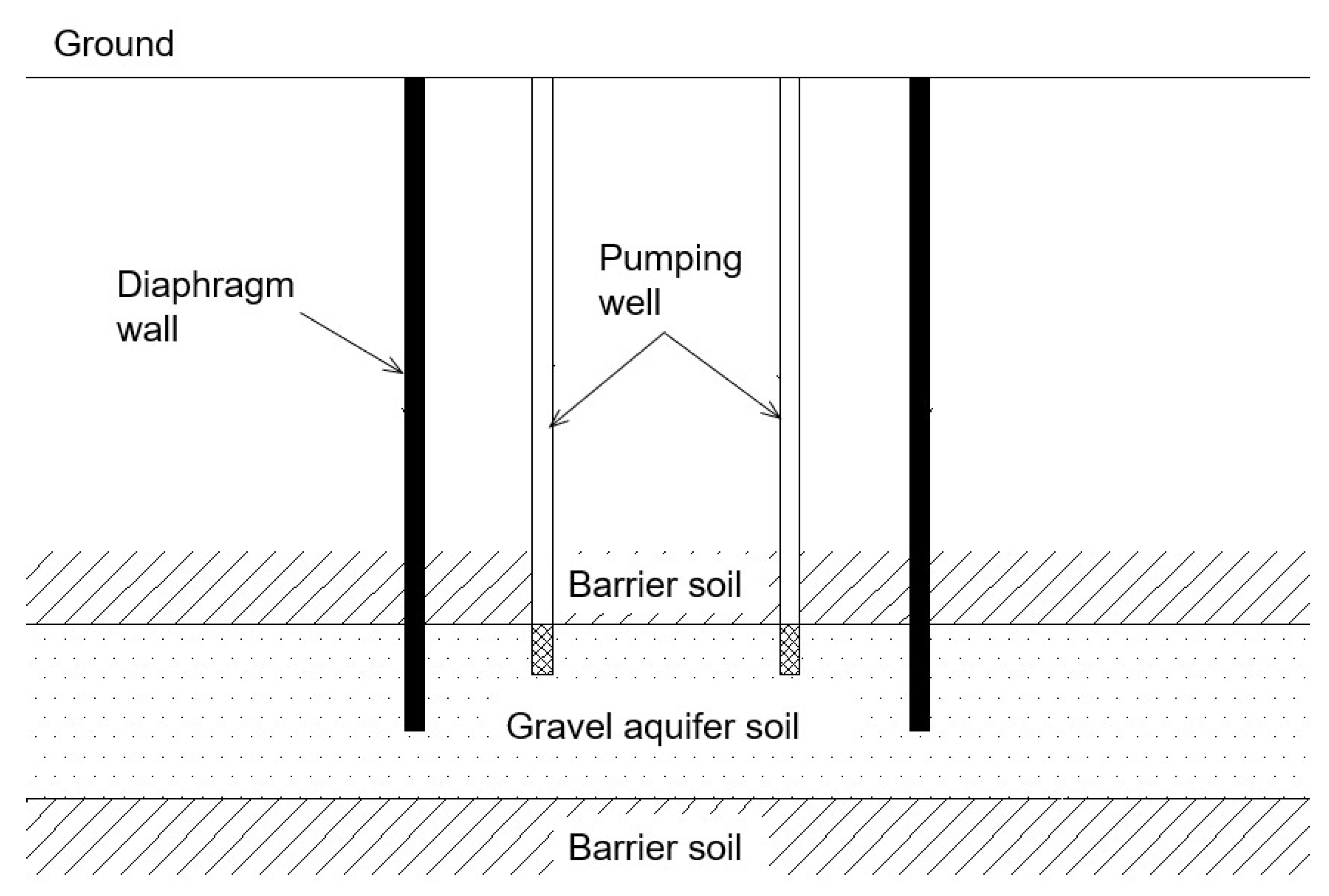
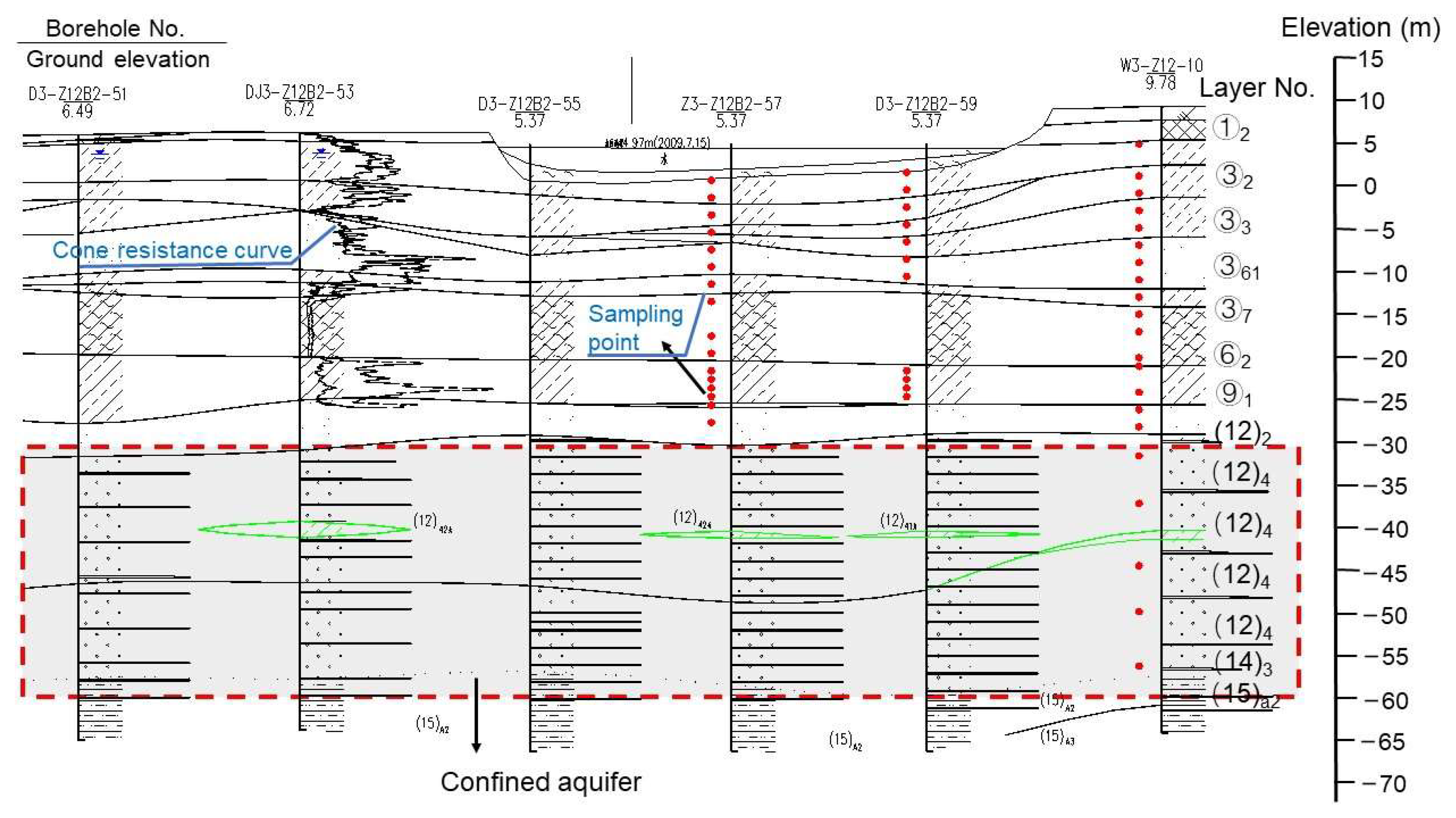

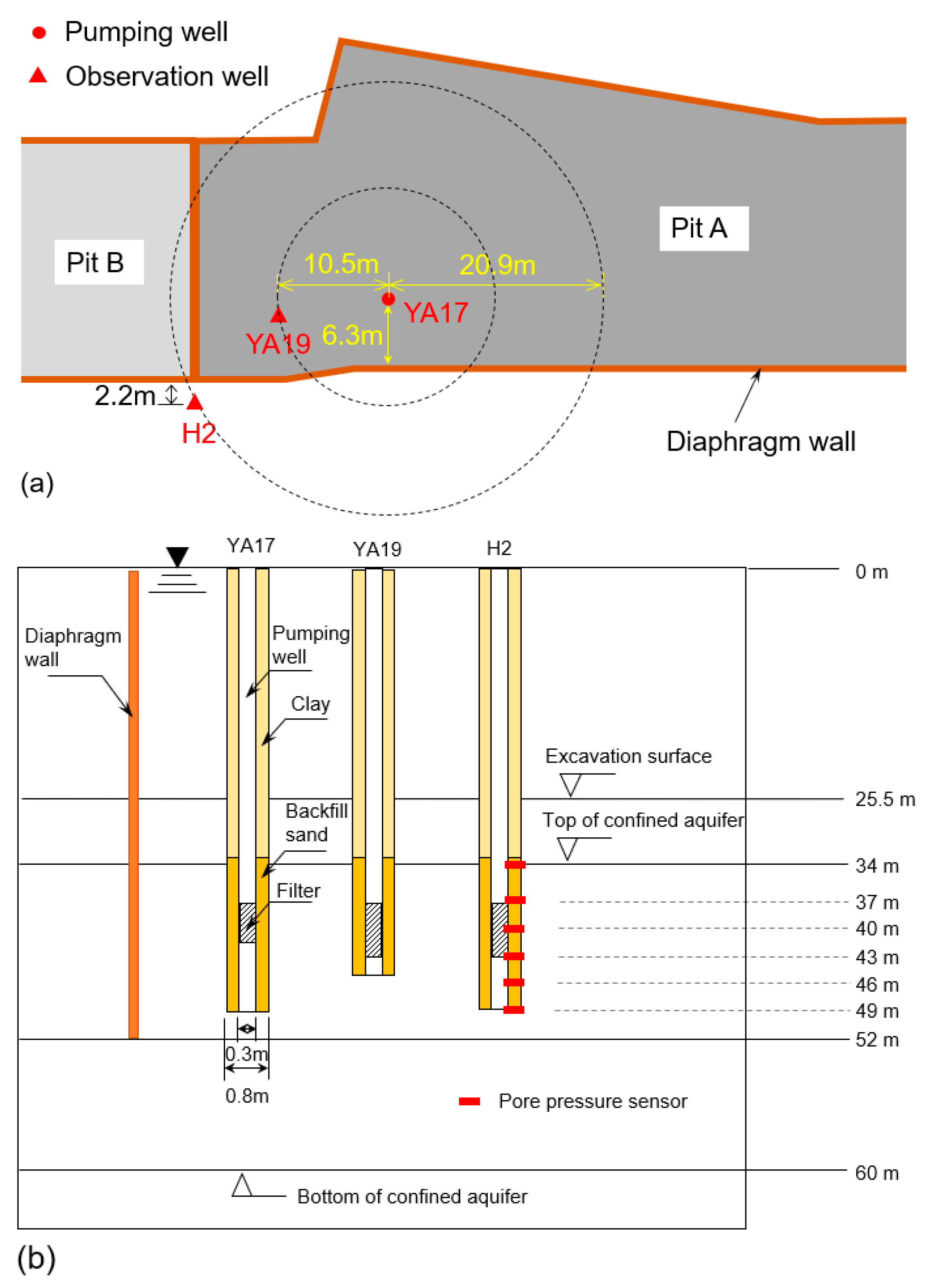
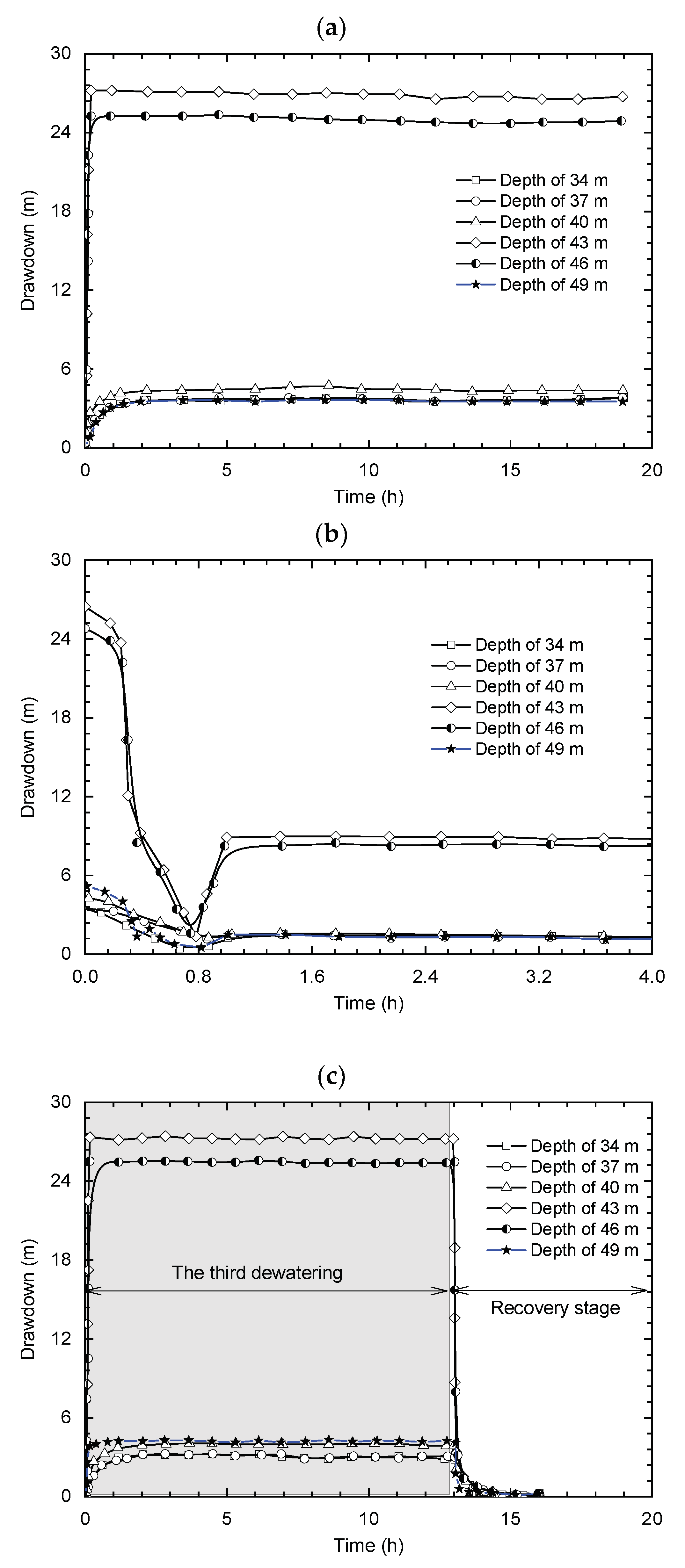

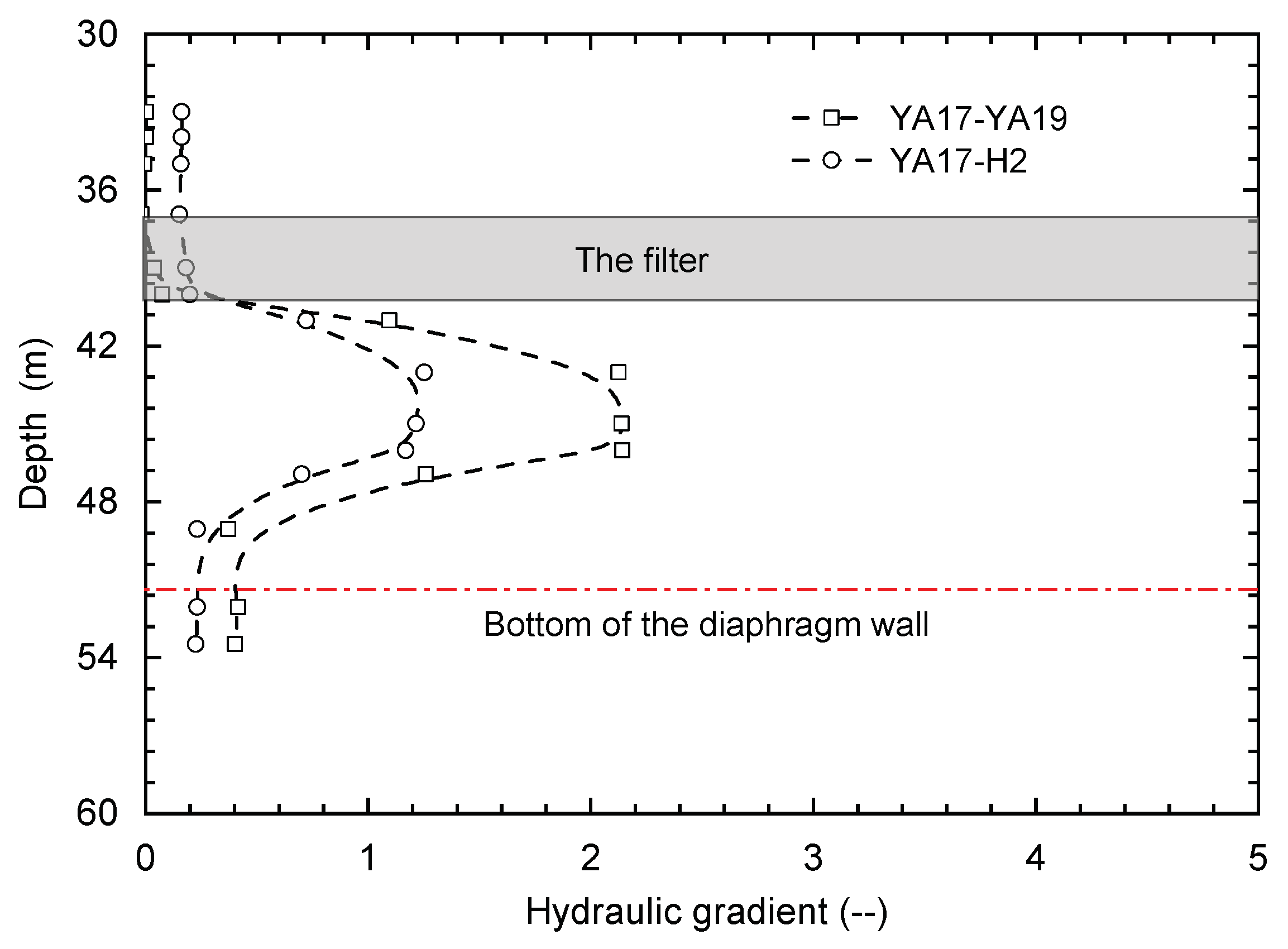


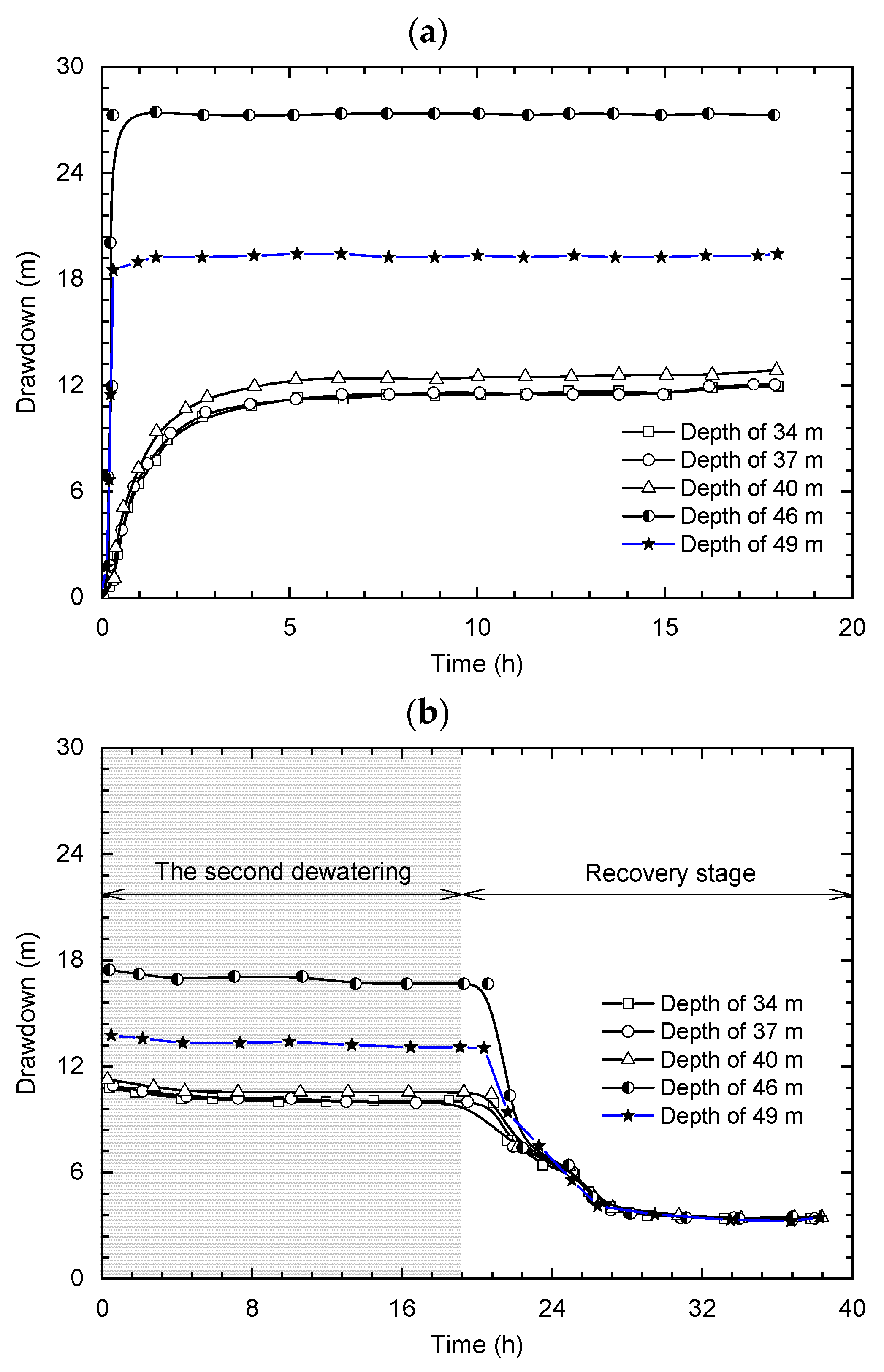

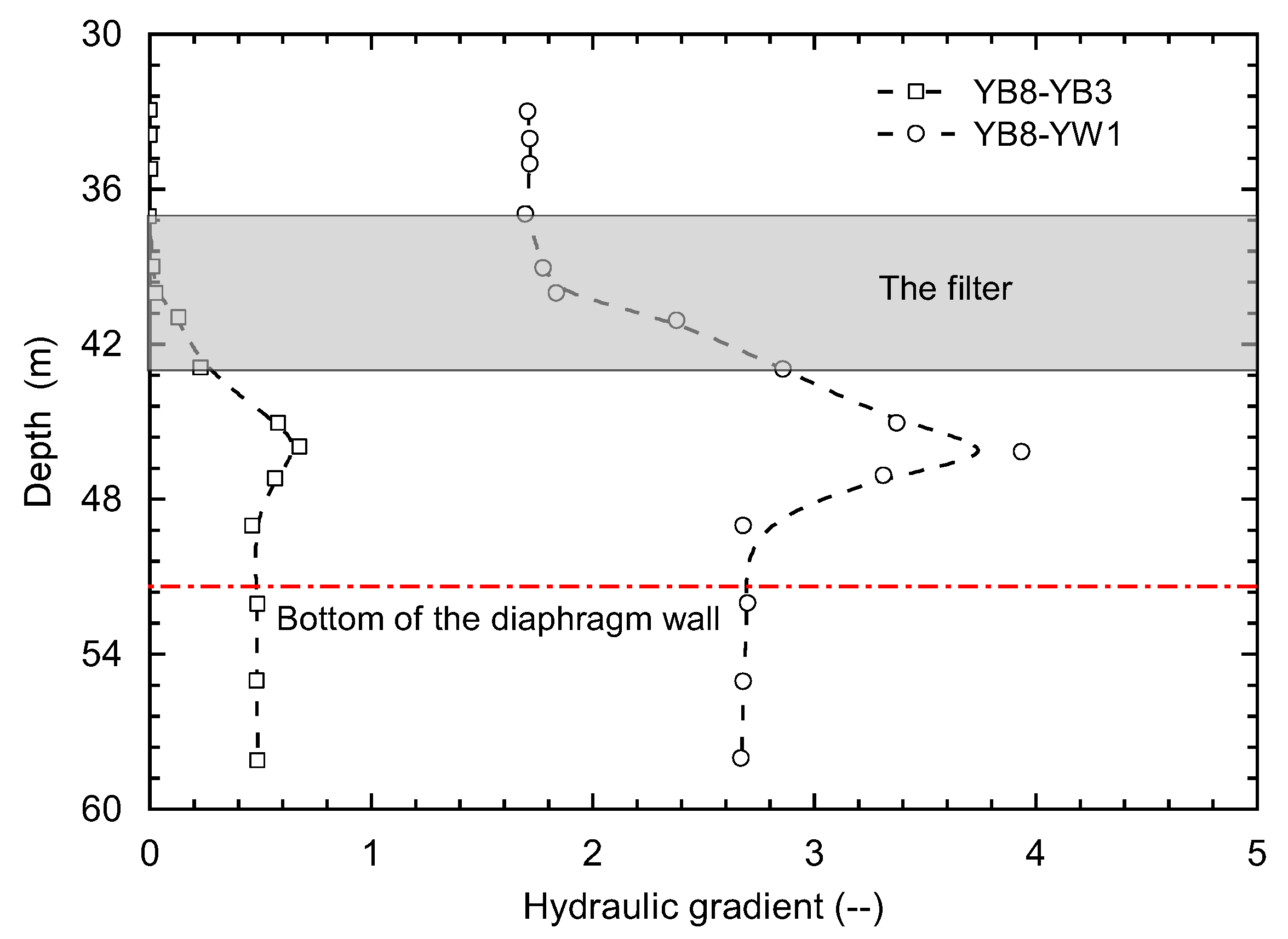
| Engineering Site | Ground Face Elevation /m | Excavation Face Elevation /m | Excavation Depth /m | Curtain Depth /m |
|---|---|---|---|---|
| Pit A | +7.0 | −18.5 | 25.5 | 52 |
| Pit B | +7.0 | −17.1 | 24.1 | 52 |
| Parameters | Depth of Sampling (m) | |||
|---|---|---|---|---|
| Miscellaneous Fill 1–2 | Silt 2–17 | Muddy Soil 17–29 | Gravel >29 | |
| Es, (MPa) | 3 | 8 | 4 | 30 |
| V | 0.31 | 0.31 | 0.42 | 0.2 |
| γ, (kN/m) | 19 | 19.1 | 17.6 | N/A |
| Kv, (m/s) | 4.0 × 10−4 | 7.0 × 10−5 | 1.4 × 10−7 | 0.9 |
| Kh, (m/s) | 5.0 × 10−4 | 8.5 × 10−5 | 2.0 × 10−7 | 0.9 |
| E | N/A | 0.82 | 1.22 | N/A |
| Pumping Well | Test Operation | Time (h) | Pump Rate |
|---|---|---|---|
| m3/h | |||
| YA17 | First round pumping | 19 | 35 |
| Second round pumping | 4 | 11 | |
| Water level recovery | 17 | -- | |
| Third round pumping | 12 | 31 | |
| Water level recovery | 12 | -- | |
| YB8 | First round pumping | 18 | 60 |
| Second round pumping | 20 | 35 | |
| Water level recovery | 11.5 | -- |
Disclaimer/Publisher’s Note: The statements, opinions and data contained in all publications are solely those of the individual author(s) and contributor(s) and not of MDPI and/or the editor(s). MDPI and/or the editor(s) disclaim responsibility for any injury to people or property resulting from any ideas, methods, instructions or products referred to in the content. |
© 2023 by the authors. Licensee MDPI, Basel, Switzerland. This article is an open access article distributed under the terms and conditions of the Creative Commons Attribution (CC BY) license (https://creativecommons.org/licenses/by/4.0/).
Share and Cite
Xu, N.; Shi, Y.; Wang, J.; Wu, Y.; Lu, J.; Zhou, R.; Huang, X.; Ye, Z. Field Experiments on 3D Groundwater Flow Patterns in the Deep Excavation of Gravel-Confined Aquifers in Ancient Riverbed Areas. Appl. Sci. 2023, 13, 10438. https://doi.org/10.3390/app131810438
Xu N, Shi Y, Wang J, Wu Y, Lu J, Zhou R, Huang X, Ye Z. Field Experiments on 3D Groundwater Flow Patterns in the Deep Excavation of Gravel-Confined Aquifers in Ancient Riverbed Areas. Applied Sciences. 2023; 13(18):10438. https://doi.org/10.3390/app131810438
Chicago/Turabian StyleXu, Na, Yujin Shi, Jianxiu Wang, Yuanbin Wu, Jianshen Lu, Ruijun Zhou, Xinlei Huang, and Zhenhua Ye. 2023. "Field Experiments on 3D Groundwater Flow Patterns in the Deep Excavation of Gravel-Confined Aquifers in Ancient Riverbed Areas" Applied Sciences 13, no. 18: 10438. https://doi.org/10.3390/app131810438
APA StyleXu, N., Shi, Y., Wang, J., Wu, Y., Lu, J., Zhou, R., Huang, X., & Ye, Z. (2023). Field Experiments on 3D Groundwater Flow Patterns in the Deep Excavation of Gravel-Confined Aquifers in Ancient Riverbed Areas. Applied Sciences, 13(18), 10438. https://doi.org/10.3390/app131810438







